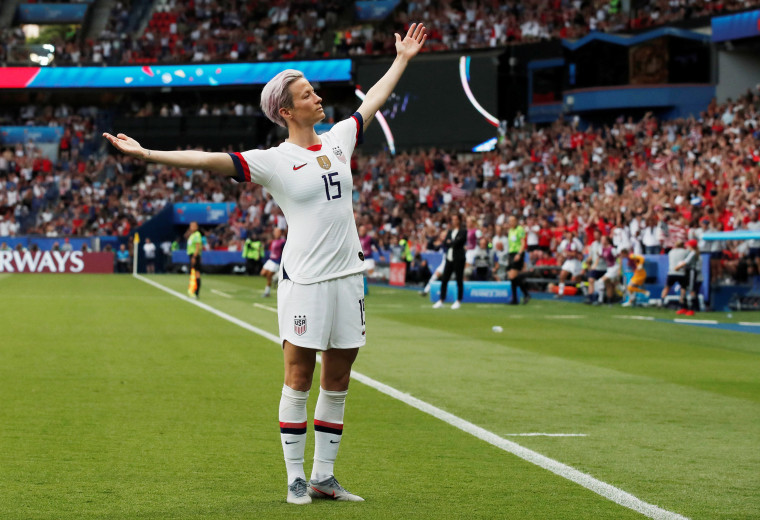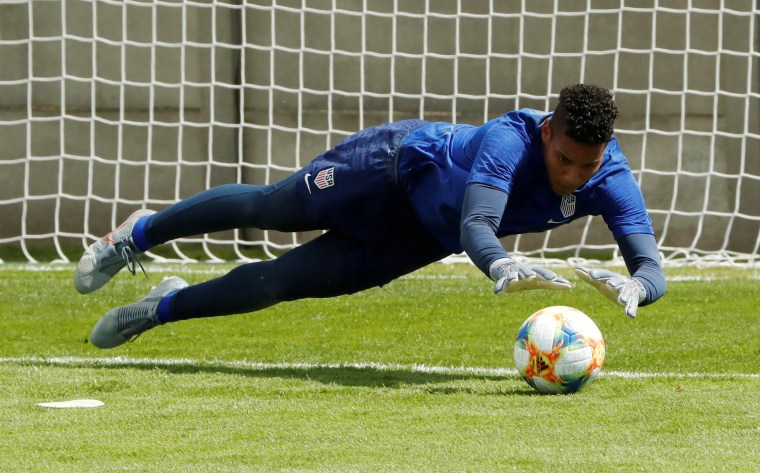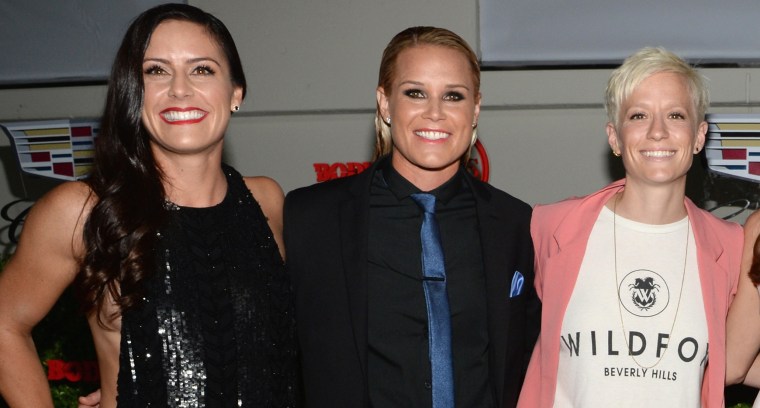The U.S. Women’s National Team, which will battle the Netherlands at the Women’s World Cup final in France on Sunday, boasts three world titles and five out and proud LGBTQ players. Two of its soccer stars — Ali Krieger and Ashlyn Harris — are engaged, and the team’s coach, Jillian Ellis, is also an out lesbian.
Women in the sport are also coming out internationally: Approximately 40 lesbian and bisexual players participated in the Women’s World Cup this year, compared to less than 20 in 2015, according to LGBTQ sports site Outsports. The Netherlands, which will face the United States in the final, also has five openly LGBTQ players.
This increasing visibility is a sign that sports are becoming more inclusive, said Cheryl Cooky, associate professor of women, gender and sexuality studies at Purdue University and co-author of “No Slam Dunk: Gender, Sport, and the Unevenness of Social Change.”
“I think it signifies partly this new generation of young women who are coming into the sport, who have grown up in a different cultural context wherein being openly out, being queer, being non-gender conforming — whatever kind of identity — are not stigmatized to the extent to which they were in the past,” Cooky told NBC News.
But in countries where homosexuality is still stigmatized, she added, many players probably remain closeted.
Gay men in professional soccer have been slower to come out. There are currently only three known openly gay professional male soccer players in the world — Collin Martin of the U.S., Anton Hysen of Sweden and Andy Brennan of Australia — and there were no openly gay men playing in the 2018 World Cup.

To date, only two players in the men’s North American Soccer League — Martin and Robbie Rogers — came out before retiring. Martin, who plays for the Minnesota United, is the only openly gay player still in the league, and the only out man in any of the big five American sports leagues.
Matt Hatzke, a former men’s professional soccer player who came out in 2015 after retiring from the San Jose Earthquakes, suspects that many gay players like himself stay closeted until they leave the sport.
“Obviously, if there are 40 women who identify as lesbian [in the Women’s World Cup], I can guarantee there is a good chance there is at least that many on the men’s side,” Hatzke speculated.

Megan Rapinoe, star forward of the U.S. team, who is popular for scoring points on the field and defending civil rights off of it, has become an icon among LGBTQ athletes of all genders.
After Rapinoe scored two goals in a 2-1 quarterfinal victory over France last week, at the tail end of LGBTQ Pride Month, she exclaimed,“Go gays!” and added, “You can’t win a championship without gays on your team — it’s never been done before, ever. That’s science, right there!”
“Right now Megan is America’s sweetheart,” said Sarah Kogod, an inclusion strategist for the You Can Play Project, an organization that advocates for LGBTQ people in sports. “It is hard not to love her regardless of how you feel about the community in general. That is good for the community, because she has been able to transcend this definition of ‘lesbian soccer player’ and just be ‘badass soccer player.’”
Even as the roster of out LGBTQ elite athletes grows, many young players continue to struggle. Only 24 percent of LGBTQ youth say they play a school sport, compared to 68 percent of all youth nationally, according to a report from the Human Rights Campaign.

Kogod said LGBTQ youth may idolize athletes like Rapinoe, but they struggle to relate to them and often lack visible role models such as teachers and coaches in their day-to-day lives.
“There is a difference between a role model and someone who provides you with visibility,” Kogod said.
There are even fewer visible role models for gay male athletes, and many of them navigate a locker room culture where anti-gay slurs and casual homophobia are the norm.
“When I was growing up, being LGBT in sports was something not even imaginable, because of that locker room talk and the locker room culture,” said Ryan Adams, 33, founder of the Minnesota-based North American Gay Soccer Association. “I was always scared to be my most authentic self. You were basically teased if you were maybe gay, if you were weaker or you were the skinny kid.”
Research indicates that many straight, cisgender (non-transgender) athletes are unaware of how prevalent homophobia is in sports and of how their own behavior may contribute to it.
A recent study by the Behavioral Sciences department at Monash University in Melbourne, Australia, which surveyed 146 players from 11 countries who play in Australia’s semiprofessional ice hockey league, revealed that 86 percent of players thought their team would be welcoming to gay players despite many of them regularly using “harmful and exclusionary” language,” The Associated Press reported.
Kogod said many athletes don’t understand that common locker room “banter” makes some players feel unwelcome. “They may not call each other ‘fags,’ but they may call each other ‘sissy,’ and it’s just as damaging,” she said.
She said this culture likely causes LGBTQ youth to avoid participating in athletics, which means many miss out on the physical, health and social benefits of playing a sport. This is especially true of transgender students, who are the least likely to participate.
There is too much focus on discrimination and not enough focus on policies at the high school level that foster inclusivity, she added. “Everyone’s looking for this one big thing to say, ‘Aha! That’s discriminatory!’” she said. “And, really, discrimination isn’t the most damaging thing — it’s the lack of true inclusion that makes someone feel not welcome to be authentic.”
Still, Kogod sees major progress for LGBTQ athletes at all levels. She said Rapinoe and other out players in the Women’s World Cup are making an impact, especially when fans see them in healthy and loving relationships.
“She’s not just a lesbian, she’s not just an LGBTQ athlete,” Kogod said. “She’s loved.”



